St. John’s Bible: Volume 2 – Historical Books
Joshua, Joshua 3:14-17, 8:30-35, 24:20-24
Joshua Anthology, Donald Jackson, Copyright 2010, The Saint John’s Bible, Saint John’s University, Collegeville, Minnesota USA. Used by permission. All rights reserved.A frenzied scene bursting with gold, purple, red and green, this anthology reveals dozens of unique motifs. The eye is immediately drawn toward the golden sky, symbolizing the glory and presence of the LORD. From there, we look down to see ghostly cities aflame on the right side of the Jordan river: a recollection of the bloodshed of conquest as the Israelites struggle against the Canaanites to inhabit the land. At the base of these cities lie words from the earlier illumination of the Ten Commandments (notice also the golden arch stamped over them, a common motif in the St. John’s Bible). In the river, headless bodies are drowned, recalling both the Red Sea experience and foretelling the death found throughout Israel’s wanderings.
On the left side of the Jordan lie threats of the wilderness and Egypt. Pensive lions stand watching the scene from the side, a structure like the golden calf just below them. At the bottom, a menacing scarab seems to crawl back to Egypt, and the Egyptian eye leers at the viewer from a distinctly Egyptian border design.
Judges

Throughout this illumination are thick black bars and narrow bands of gold, rising and descending, climbing and falling. There are flames. At the top, wild dogs devour the people. At the base of the illumination, more wild dogs devour the people and arrows pierce them. There is blood and fire and, above all, chaos. There is no sense in this illumination of progress or stability, of growth and transformation. Three golden calf idols emerge at various places in the illumination, which is bordered on the right by hieroglyphics.
The Israelites may have asserted themselves militarily, but they had not unified themselves culturally. They were still, in many ways, slaves to their old ways, and for that, artist Donald Jackson has included Egyptian themes throughout the Judges illuminations. After completing this one, he returned to add a final layer, the black batons. We see them as corruptions of the gold batons that suggest divine presence; and though gold wedges still persist in this image, they are “sort of scurrying around, almost like divine sheep dogs, trying to pull all these people together…” It is the goodbye to the Egyptian chapter before the Israelites’ era of prophets and kings.
Ruth
Ruth and Naomi, Ruth 1:16-18
The book of Ruth is like an oasis in the Historical Books. It reminds us that there is love in the world, as well as kindness and kinship. After the recounts of “Judges” and the ongoing captivity and redemption of the Israelites, we are allowed to simply focus for a moment on the story of a woman and her mother-in-law. Both are widows. One of them—a Moabite—still contributed to the line of David.
The image of Ruth and Naomi shows the backs of the two women with their gaze fixed ahead, sitting side by side, looking to their future. They are dressed in flowing clothing and presumably at peace.
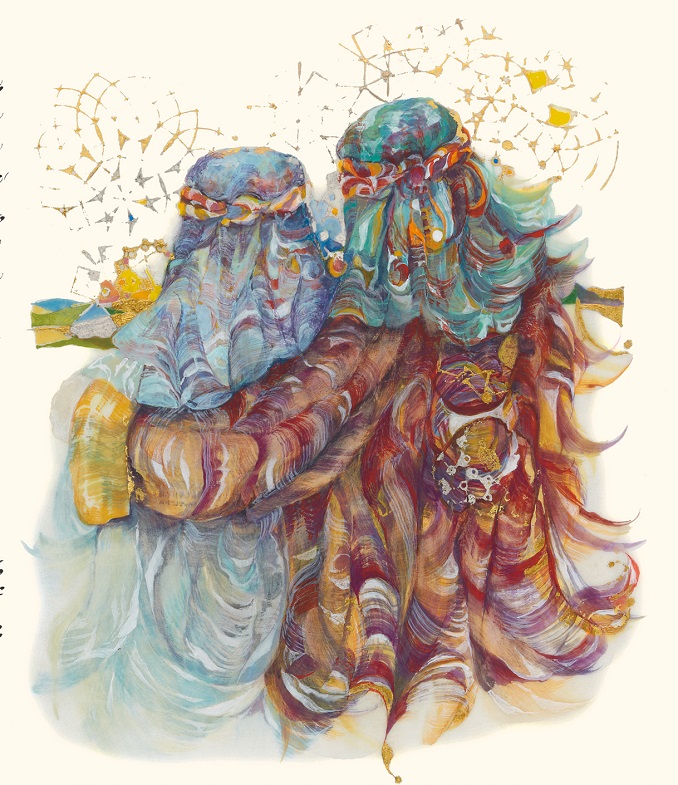
Ruth the Gleaner, Ruth 2:2—23

To help care for Naomi., her mother-in-law, Ruth takes on the task of gleaning, walking behind the harvesters to pick up the meager grain left behind. This display of Ruth’s love for her mother-in-law and also, presumably, Ruth’s beauty, catches the eye of Boaz. Because of her marriage to him, two widows—one a foreigner, the lowest in rank in the area—find favor with the Lord and are rescued. The story of Ruth is a glimpse of the kingdom, of what God has in mind for Israel, a happily-ever-after.
The illumination of Ruth, the Gleaner, particularly reflects the movement in the story from famine, barrenness, and isolation in Moab to plenitude, fruitfulness, and community in Bethlehem, that famous city. The swirling image at Ruth’s center in this illumination is more than a basket of grain. It seems to speak to the abundance and fertility at the center of Ruth’s being, an extension of her swirling skirts.
The book of Ruth concludes with a special text treatment by Donald Jackson. Above the text treatment are seven stars of David. Beneath it is another representation of a menorah. The stars can be seen as flames on the menorah candles or simply as an extension of the motif. The treatment itself is of the genealogy, the women naming Ruth’s son Obed, and the line into which he fits—from Perez, son of Judah by Tamar, to Obed, father of Jesse, the father of King David.
Hannah’s Prayer, 1 Samuel 1:11; 2:1—10
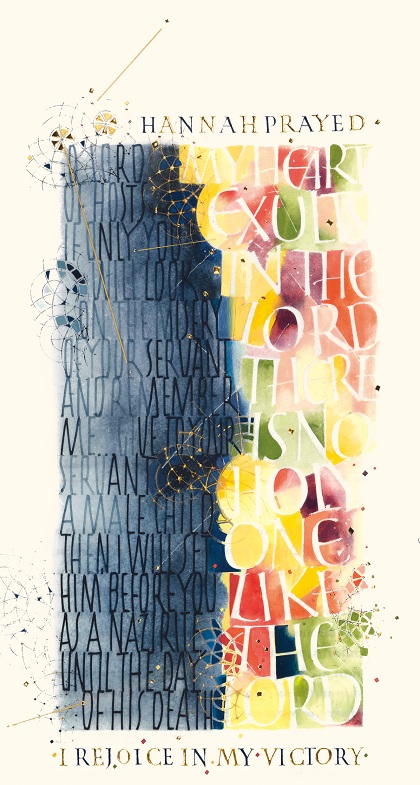
Hannah’s Prayer, Thomas Ingmire, Copyright 2010, The Saint John’s Bible, Saint John’s University, Collegeville, Minnesota USA. Used by permission. All rights reserved.This block-text illustration exhibits two (starkly different) prayers: one of anguish and one of gratitude. Hannah, the future mother of Samuel, laments over her barrenness on the left, and rejoices in God’s promise on the right. The ghostly text speaks to her humility and her lack of power in the temple. But because “the LORD remembered her” (1:19), she also rejoices in the birth of her son Samuel—a joy evident in the bright and multicolored side of the illustration.
Call of Samuel, I Samuel 3:1—18
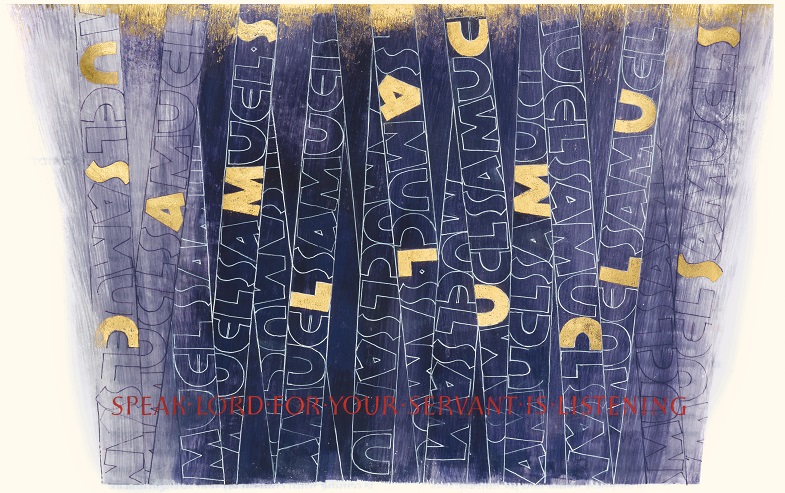
Samuel’s name fills this whole illustration, layered in vertical strips. Like the three calls by God at night that awoke Samuel, each strip is its own message, albeit with the same content. Random letters are colored in gold leaflets, enough to be unscrambled and arranged into one divine call of his name. This process is not unlike Samuel learning to hear God’s voice and to recognize it in the simple language that awakes him again and again.
Saul Anthology, 1 Samuel 9—31
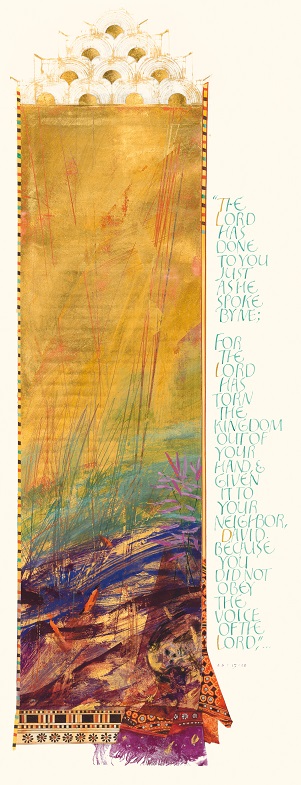
This illumination uses the three colors—gold, green, and purple—emphasized in the Historical Books. The focus is on Sau;’s kingship, and by using a single column, the illumination reflects the hierarchy of God’s kingdom, the realm of priests and prophets, and finally the realm of kings. As we see, the heavenly kingdom is beautiful, and the crown of golden archways at the top is suggestive of heavenly mansions. Israel is favored, but the story is always complex. The green realm demonstrates the presence of Samuel, who guides Israel and advises Saul throughout Saul’s reign. The text in the margin of the illumination is the final words of Samuel in chapter 28. In this astonishing passage, Samuel speaks from the dead, through a medium, to tell Saul yet again that his kingship has been handed over by God to David. His words are in green with gold caps, suggestive of his place now after death and of the power of his prophecy.
Finally, there is the realm of purple, Saul’s kingship, also shot through with gold. We see the presence of a prayer shawl with dangling fringes but also with the Egyptian motif. There are occasional flames, the warring nature of his kingship, and, in the shadow of the prayer shawl, a skull. Saul’s skull is separated from his body by the Philistines, and his body is placed on the wall. The men of Israel take his body and those of his sons who were slain with him, burn them, and bury their bones beneath the tamarisk tree in Jabesh. A tree stands above the skull in the illumination, suggestive of the tamarisk and also of the young monarchy taking root in Israel. The book closes with the men of Israel beginning a seven-day fast, the next stage in a cycle that always ends with repentance and an appeal to God for deliverance.
David’s Lament (How the Mighty Have Fallen), 2 Samuel 1:19—27
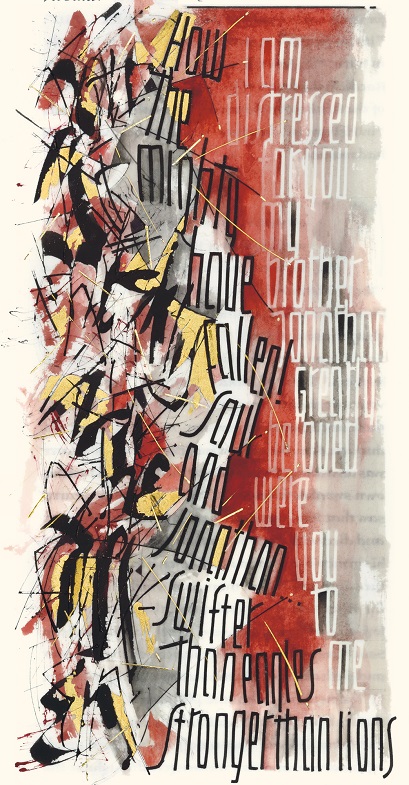
First Samuel began with Hannah’s prayer to the Lord expressing her sorrow over barrenness. Second Samuel begins with David mourning the deaths of Saul and Jonathan. This illustration depicts the song, in vertical panels, and shows David’s multiple emotions: the anger that drives him to kill the Amalekite, the anguish behind the song’s public line, “How the mighty have fallen!” and the more personal grief over Jonathan’s death, depicted like a shadow engraved on this page.
These emotions clatter against one another, much like the columned words on the right and incoherent chaos on the left. Looking closely, you can almost make out letters among the slew of black, gold, and red lines. But nothing, in its original state, is comprehensible. It eventually takes shape toward the right side of the page, giving the viewer a sense of David processing the deaths of his best friend and father-in-law.

David’s Anthology, 1 Samuel 16— 2 Samuel 24
This illustration—an anthology of one of the most versatile characters in the Bible—simplifies the life of David to a single vision of Israel in his time. The seven panels, echo the seven panels of Creation. David’s kingship is a significant restoration of the establishment of God’s kingdom.
The clearest images in the illumination are the gold-stamped archways, a recurring symbol throughout the Historical Books volume of The Saint John’s Bible. They give the impression of both a cathedral and a fortress: God’s holiness manifested in His protection of that which He has called holy (notice the ark of the covenant at the bottom left). Throughout the Bible, people seek God in sacred spaces, and David epitomizes this in bringing the ark to Jerusalem.
The seven panels topped with gold, provide a faint echo of the menorah and the sense of David’s place in the covenant story of Israel. God has made a covenant with David, as with Abraham, that will be ultimately fulfilled in the birth of Jesus.
Solomon’s Temple, 1 Kings 8:1—66

Though King David brought the Ark of the Covenant to Jerusalem, it is his son Solomon who built the Temple, giving Israel a permanent kingdom and a central place to worship the LORD. Chapters 5—8 of 1 Kings go into great detail about the plans, furnishings, and building of the temple. There is so much detail that, over time, people have built realistic models of it. Isaac Newton made extensive drawings of it, believing it followed a “sacred geometry” revealed to Solomon. There are definite, although minimal, similarities between the architectural look of Donald Jackson’s various images here and Isaac Newton’s drawings.
Marking the four corners of this page are images of the Temple. The emphasis is on the historical Temple elements: the two cherubim, the gates and arches on all sides of the page, and the gold box that represents the Holy of Holies, wherein would lie the Ark of the Covenant. However, the rest of what we see in these images is mystery, hinting at the vision of the Temple in Ezekiel. We see that most explicitly in the labyrinth (top left). The primary color here is purple, suggesting the majesty of the kingdom united by David and consolidated under Solomon. Solomon’s prayer, inscribed on the margin, celebrates a right relationship with God.
A rainbow theme is also more pronounced in the details on the two pages. Here we see that idealized, dreamlike vision of the kingdom, with palm trees and golden archways. The Temple is only part of the vision realized—the ideal kingdom is yet to be experienced.
Elijah and the Fiery Chariot, 2 Kings 1:1—14
The two figures in this illumination are the prophets Elisha and Elijah. Although we think of the story of Elijah and the
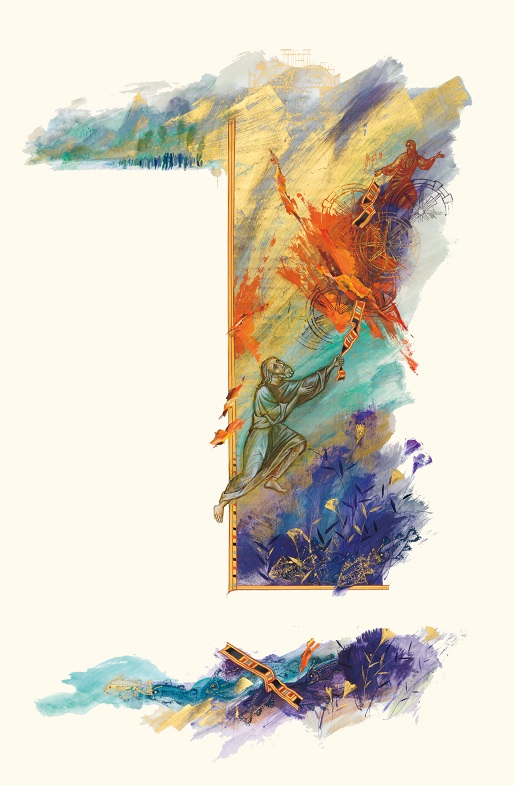
fiery chariot as one of God’s triumph, we can tell by the look on Elisha’s face that he is worried. In the Scripture passage, Elijah and Elisha are journeying. Elijah asks Elisha three times to stop and wait, but Elisha insists on following Elijah to the end of his journey. The three points of the journey are Bethel, Jericho, and the Jordan. In a way, Elijah is retracing the steps back to where we last saw Moses. The prophets pass through Bethel, where the ark of the covenant was housed, and where Jacob received the name Israel. Next they stop at Jericho, site of the famous first battle by Joshua when the Israelites entered the Promised Land. Finally they cross the Jordan, and Elijah parts the waters with his mantle, reminding us of Moses parting the Red Sea. After this, Elisha asks for a “double portion” of Elijah’s spirit. Elijah throws down his mantle as he is taken up into Heaven—a sign of his outpouring.
In this illumination, we see many elements of the story. At the top left are the groups of prophets waiting to see what God will do. Elisha, saddened by the loss of his predecessor and grabbing hold of his own destiny, looks to Elijah being transported to heaven amid fire and chariot wheels. At the top center is the arch, ever present in Historical Books as the arches of the kingdom of God’s ongoing covenant to raise up a people. And below are fish, reeds, and river, suggesting the River Jordan, which the two prophets have crossed to reach this place. The colors are also quite intentionally used here—the purple of the earthly kingdom, the green of prophecy and priesthood, and the gold of God’s heaven to which they aspire.
Elisha and the Six Miracles, 2 Kings 4—6
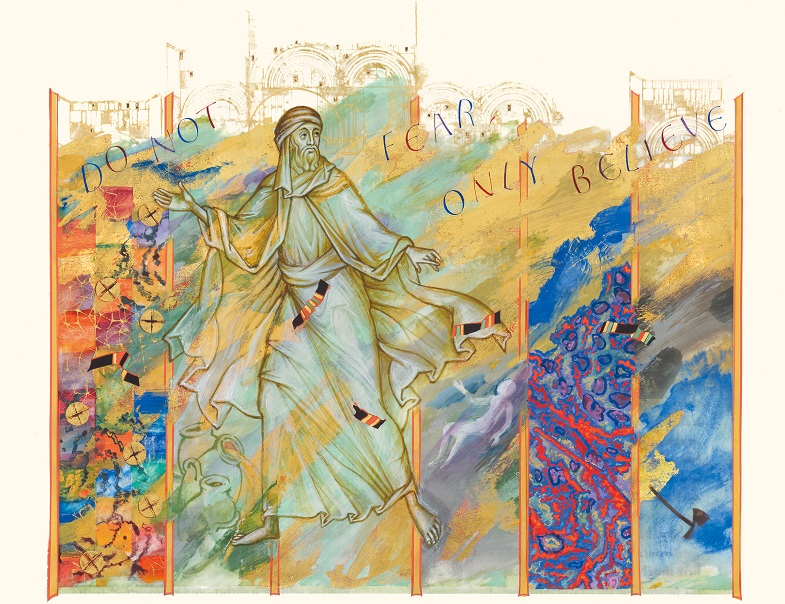
Elisha, wearing Elijah’s mantle, is surrounded by six panels depicting his miracles. He is green, the color of priests and prophets. A transparent wash of color seems to embed him in the panels, making him part of the events.
In the first panel are depictions of bread, as Elisha feeds the multitude on a few loaves of barley. This miracle is twinned to another of Elisha’s miracles: the purification of the poisoned pot of stew by throwing a handful of flour into it. The second panel depicts the jugs of overflowing oil that benefitted the widow and her son. Elisha provides these as a means for getting the widow out of debt. The third and fourth panels depict Elisha’s healing ministry. After first making it possible that the Shunammite woman will have a son, he later returns to her house and, because of her faith, raises her son from the dead. The quote written across this illumination is actually words of Jesus, “Do not fear, only believe” (Mark 5:36).
In the fifth miracle, Elisha, encounters Namaan, an Aramite commander of the enemy’s army. Namaan seeks him out because he has leprosy, and his servant, an Israelite captive, has said the prophet would cure him. When Elisha sends word that Namaan should just wash himself in the Jordan seven times and he will be clean, Namaan is furious. But he eventually does as he has been instructed, is healed, and turns to worship the LORD.
Finally, the miracle of the ax floating on the waters of the Jordan: provision for a prophet to build his house when he loses his ax head in the river. When Elisha throws a stick near the place where the ax went under, it floats to the top and the prophet lifts it out.
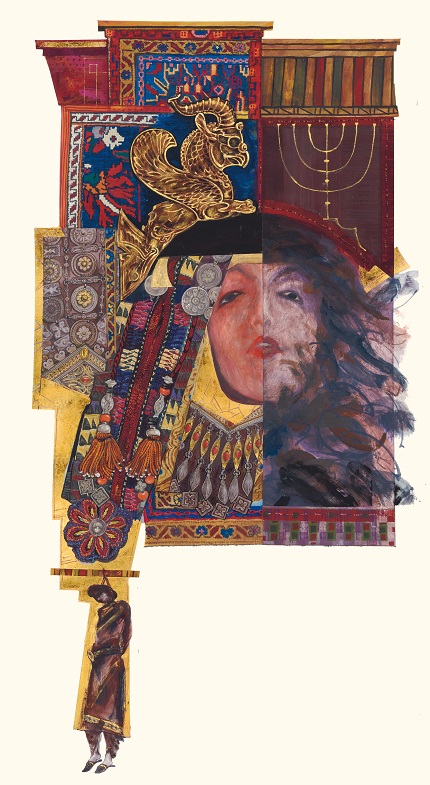
Esther, Esther 5:1—14
Esther was both a beautiful Jewish woman, shown on the right crowned by the menorah, and, as seen on the left, queen of Persia, chosen from among all the beauties of the empire to be the king’s wife. Here in the illumination of Esther, The illumination layers images of the opulence as well as the integrity of the queen, a contrast heightened by Esther’s own words in the margin: “You know that I hate the splendor of the wicked” (14:15).
One striking feature of this illumination is the hanged man. This figure, Haman, who attempted to destroy the Jews and was himself destroyed, wears a rather contemporary-looking tunic and has sad, limply hanging slippers. It is based on images of public execution in Saudi Arabia, and it is intended to make us uncomfortable. It pushes the violence of all the Historical Books to the foreground, and resonates with the violence still present in our own time.